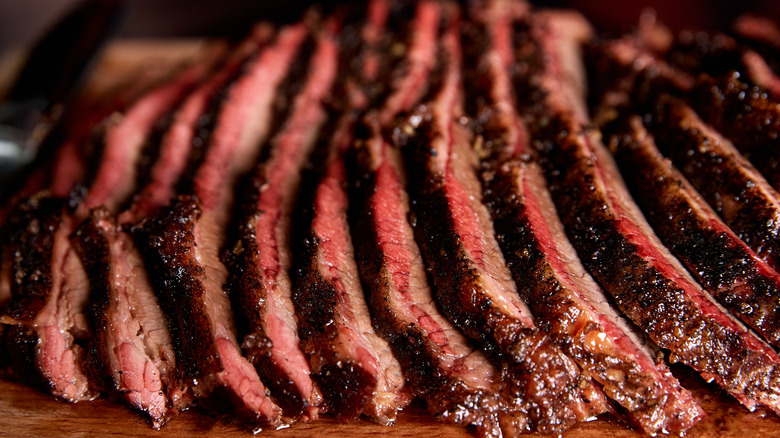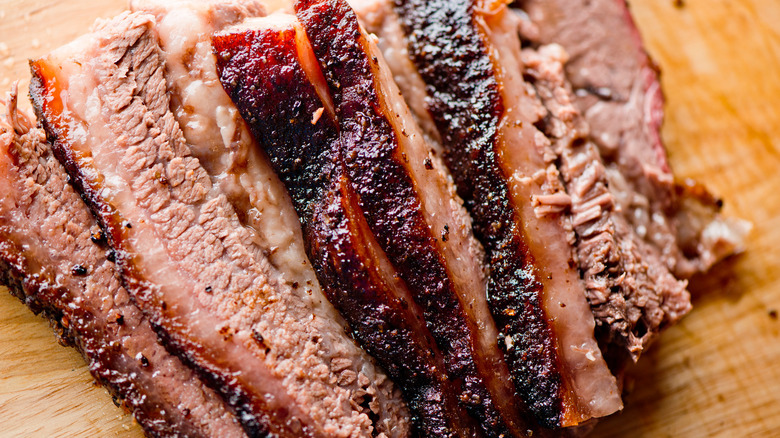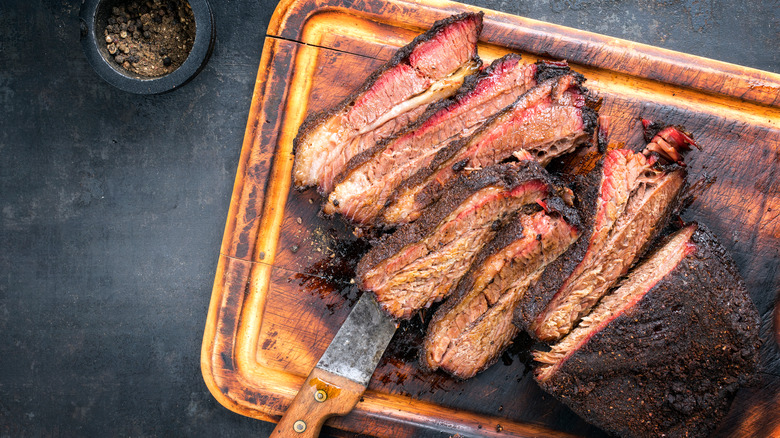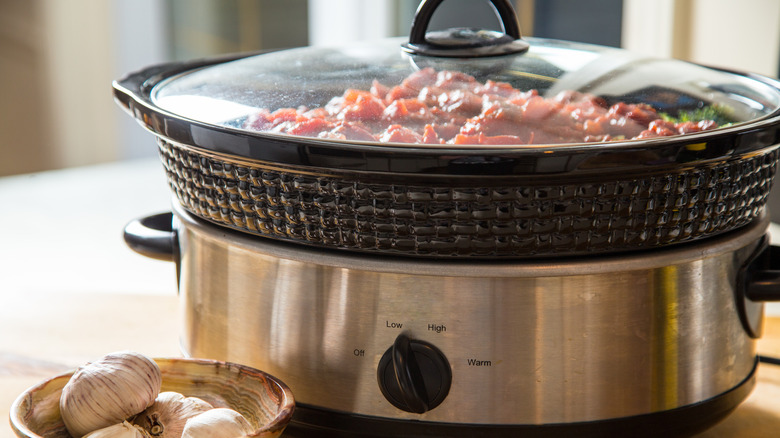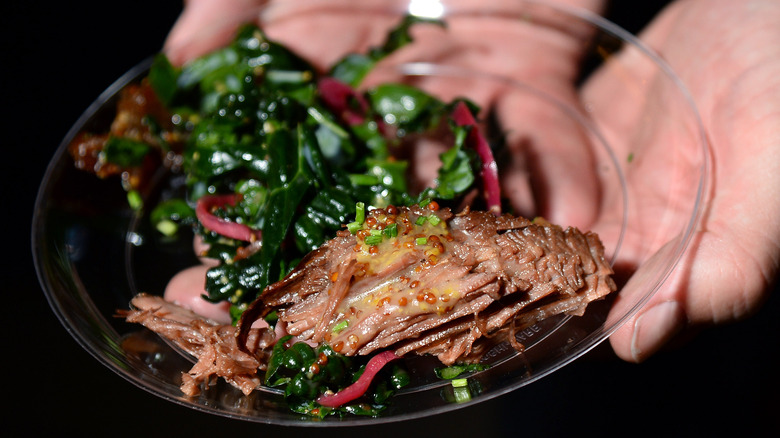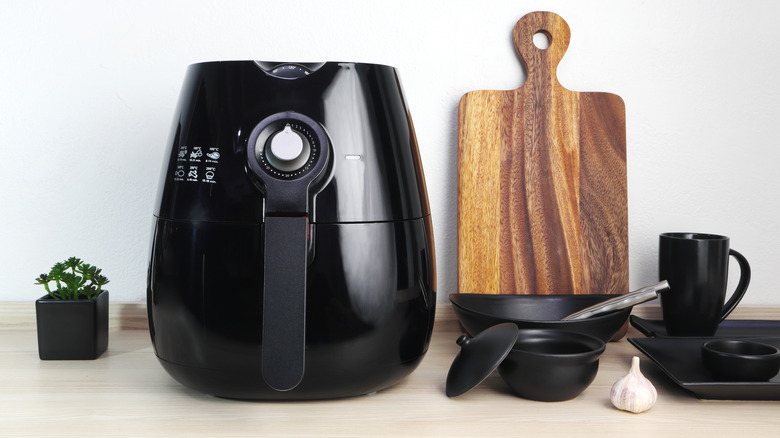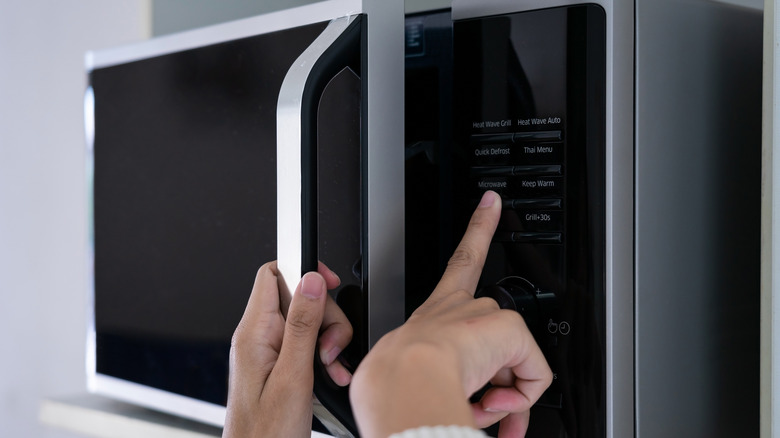You've Been Reheating Brisket Wrong Your Whole Life
A perfectly cooked brisket can be the highlight of a regular dinner during the week or even a fancy holiday dinner, usually with plenty of leftovers to carry you through a few extra meals. But, whether you're warming up enough to feed a whole crowd, or just a few slices that you stashed away when nobody was looking (the chef should get first dibs!), a few missteps could mean you end up with dry and flavorless meat, says the Food Network. And nothing, we mean nothing, is worse than dry brisket. You worked so hard to cook it to perfection, and it deserves more than popping it haplessly into the microwave and nuking it for a few minutes. But, fear not, there are some very simple ways to make this favorite dish taste fantastic — even a day or two later.
The proper reheating process actually starts even before you wrap up the leftovers. According to the blog The Grilling Dad, it's essential to slice the brisket first, and then you'll want to bring it to room temperature while remaining in its juices before you wrap it up and store it. Doing so will keep it moist and retain its softer texture too. Whether you are using an oven, a smoker, a slow cooker, a sous vide, or a microwave, the next steps will guarantee your precious cut of beef will remain delicious.
Warm it up in the oven
According to Southern Living, the best way to reheat your leftover brisket is to apply the same method that you originally used to cook it. But, they also recommend placing it in an oven if you can't put your meat back in a smoker, sous vide, or any other appliance that you first used. The one thing they do stress, is that "low and slow is key." Turning up the temperature to get it to cook faster will only result in reducing the moisture content and turn it into jerky.
They recommend letting the sliced brisket sit at room temperature for about a half-hour, while preheating your oven to 325 degrees Fahrenheit. Then, place it in a dish and pour any saved juices, or beef broth, over it and cover tightly with two layers of foil. According to the USDA guidelines regarding leftovers, your goal is for the internal temperature to hit 165 degrees Fahrenheit before serving it. Then scream, "dinner!" at the top of your lungs and wait for everyone to come rushing in.
Fire up a pre-heated smoker
Reheating your brisket in a smoker or on a grill is much the same as reheating it in the oven, only it will take a bit longer. The blog Simply Meat Smoking recommends bringing your meat to room temperature, tightly wrapping it in foil while you preheat your smoker to 225 degrees Fahrenheit, and then using the "2-zone cooking method" for the reheating process. The reason being that "using direct heat on pre-cooked meat can dry it out further and you may also overcook it in the process."
If you're using a grill instead, make sure it's set to medium-heat before you begin. Ideally, you should use a meat thermometer to monitor the temperature and as soon as it hits 155 degrees Fahrenheit, remove the brisket from the foil, and then use direct heat until it reaches about 160 degrees Fahrenheit. When ready, chop it up and throw it on a roll for a killer sandwich, or eat it slice-by-slice until it's gone, or serve it with a whole host of barbecue sides. The options are endless.
Warm it gradually using the slow cooker method
While a slow cooker is a convenient way to cook brisket until it's tender, it can be invaluable when reheating leftovers as well. And, while it's certainly not quick (hence, the word slow in its name), there's something about the ease of "setting it and forgetting it," says PureWow, that you just can't beat. As with the other methods, you should start by allowing the brisket to reach room temperature, says the article. Once you have done this, place the meat directly in the slow cooker, cover with leftover juices or beef stock, cover the pot, and set it to low heat.
Then, wait. PureWow recommends heating it for about four hours. But, if you really have some extra time on your hands, after it's cooking, take it out and wrap it up with some of its juice in a sheet of foil. Let it sit for an additional 10 minutes for an extra juicy dish — that is, if your head hasn't already exploded because you can't wait any longer.
Use a sous vide to give it a 'warm bath'
Feeling fancy? Heat up your leftover brisket using a sous vide machine, or even just a food vacuum sealer, which really works to warm the meat up without drying it out. BBQ Revolution likens this method to giving your brisket a "gentle water bath." The only drawback is that if you thought waiting four hours using your slow cooker was a long time, then buckle up, because the blog estimates that the sous vide reheating method can take up to five hours.
But wait! You can reduce the time by cooking slices individually — 1/2-inch slices should only take 10-15 minutes to heat up, while 2-inch slices will take about 2 hours to reheat, they say. Livestrong recommends heating your water to 110 to 175 degrees Fahrenheit, then putting the vacuum-sealed brisket in a pot and letting it soak until "its internal temperature reaches the same temperature as the water." Don't have a sous vide machine? According to Simply Meat Smoking, you can use a pot of boiling water instead. Wait for the water to reach 150 degrees Fahrenheit, and then submerge your sealed brisket until it reaches the same temperature as the water.
Make it a little crispy with an air fryer
An air fryer can do so many things — you can even use it to heat up leftover brisket. PureWow explains that, because they are so similar to convection ovens (where a fan and exhaust system is used to warm food up), air fryers can heat your brisket evenly and quickly. But, the downside is that this method could result in meat on the drier side. If you are willing to take that risk, set your leftovers out until they reach room temperature, set your appliance to 350 degrees Fahrenheit, place the meat on a sheet of aluminum foil with its juices, drippings, or broth, and wrap it up before putting it in the basket. After about 35 minutes, or when the internal temperature reaches 140 degrees Fahrenheit, it should be done (via Angry BBQ).
Even better, you don't have to save the air fryer exclusively for heating up brisket. You can actually cook it this way the first time. Adventures In Everyday Cooking recommends cutting your brisket first so that it fits in whatever size tray you have, applying a dry rub of "chili powder, garlic powder, onion powder, black pepper, salt, sugar, dry mustard, and a bay leaf," then placing the meat in your air fryer (they suggest using a temp of 350 degrees Fahrenheit) and let it cook for an hour. At the end of the hour, place the meat in foil, add beef stock, seal tightly, lower the temperature in the air fryer to 300 degrees Fahrenheit, and then cook for another three hours.
Use the microwave as a last resort
While technically, you can microwave your brisket to heat it up, you probably shouldn't. Southern Living explains that, because it creates steam, microwaving your once tender brisket will "steam all of its good moisture out" and ultimately turn it into a dry and tough mess. Ok, ok — you have absolutely zero time on your hands and there are no other options but to microwave it.
Go for it, but note Own The Grill advises reducing your microwave to 20% capacity and reheating the meat every 30 seconds until ready to prevent it from becoming inedible. And, whatever you do, make sure to include some juices in your container or spray it with broth or apple juice before reheating. This method will probably work best with meat that has been cooked in a slow cooker or by stovetop (via Simply Meat Smoking). Don't say we didn't warn you!
